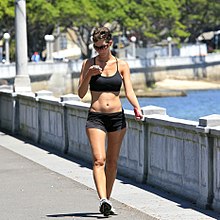Instagram may have made Gymshark famous, but it would not be nearly as valuable were it not for the “athleisure” trend
You don’t have to be a riveter to wear jeans and now, says Adrian Wooldridge, you don’t have to be fit to wear sportswear. Athleisure brands like Lululemon and Juicy Couture highlight the world’s new social division between the fat-fighters and the rest of us. From 1843
Athleisure is a fabricated style of clothing typically worn during athletic activities and in other settings, such as at the workplace, at school, or at other casual or social occasions.[1][2] Athleisure outfits can include yoga pants, tights, sneakers, leggings[3] and shorts,[4][5] that "look like athletic wear", characterized as "fashionable, dressed up sweats and exercise clothing".[6][7] The idea is that gym clothes are supposedly making their way out of the gym and becoming a larger part of people's everyday wardrobes.[3]
Athleisure can be considered as a fashion industry movement, enabled by improved textile materials, which allow sportswear to be more versatile, comfortable, and fashionable.[8]
Contents
Background[edit]
By some accounts, the athleisure trend grew out of women wearing yoga pants.[9] Another account suggests that the trend came about because people could wear them for multiple occasions without having to change, which meant greater convenience since people did not have to carry an extra gym outfit on the way to the office, for example.[3] A decade ago, denim workwear uniforms were more popular, but today, athleisure is increasingly popular in places such as public streets and fashion stores and fashion runways.[10] Sportswear that had been worn exclusively in gyms is now being worn elsewhere by young adults and fitness-conscious consumers and has been accompanied by a relaxation in dress codes. Its popularity may have stemmed from its ability to fill a gap in the market, when sportswear was once merely functional rather than stylish.[11] Due to innovations in textiles and technology, improvements have been made in functionality, such that garments and footwear have become more breathable, lightweight, and waterproof. The new garments are performance enhancing, in the sense that they allow wearers to carry out everyday activities easily.[12]
Consumer trends[edit]
Athleisure buyers desire the active lifestyle that comes with each purchase.[13] The styles, colors, and fabrics of athleisure suggest a broader emphasis on fashion as opposed to functionality.[14]
Sales trends[edit]
Reports in USA Today and The Wall Street Journal describe the athleisure market as growing,[1] displacing typical workwear styles, and cutting in to sales of jeans,[15] with a market size in 2014 as $35 billion, representing an 8% increase from the previous year.[6] According to one estimate, the athleisure market, including footwear, was $270 billion in 2016, and was estimated to grow by 30% by the year 2020.[16]
Market size[edit]
In 2016, the global athleisure sector was valued at over US$83 billion,[17] while the U.S. market reported a 16% increase to US$44 billion. A 30% growth is also predicted in Asia and the U.S. by 2020.[17] Furthermore, analysts at Morgan Stanley, believe that global sales may therefore rise to over US$350 billion.[18]
In spite of this, there is an arising issue regarding market saturation, due to the continuous entry of traditional luxury, and mass merchant brands, tapping into this trend.[10] The athleisure market for casual athletic clothing, which took off a few years ago, also has become increasingly crowded with big-box retailers such as Wal-Mart and Target, as well as fast-fashion brands joining the fray—often at cheaper prices.[15] An analyst estimated that the athleisure market was not slowing down, with much competition and pressure on various retail outlets including sporting goods stores.[15] Therefore, the best performing brands have proven their ability to withstand the emerging competition, as they sell clothes and a lifestyle as a package.[13]
Impacts[edit]
Social[edit]
Global shifts toward a rise in health and fitness trends has led to growing interest and participation in sports among the public. Many have actively joined clubs and competitions in order to fully adopt the characteristics of this lifestyle. Consequently, sportswear brands can utilize this opportunity to improve and introduce better quality apparel, footwear, and gear. By presenting their devotion towards a lifestyle, it thus allows brands to garner customer loyalty.[19]
Athleisure has been promoted by celebrities such as Beyoncé and Rihanna.[20] The athleisure market is characterized by continuous innovation and brand differentiation.[21]
Materials and technology[edit]
New fibers enable greater odor reduction, sweat-wicking, stretchability to conform to the body's shape, breathability to allow air in and out, and protection from dirt.[20][22] Some clothing designs permit selected parts of the clothing to allow more breathability while other parts can have greater tension, perhaps as a way to aid posture.[23] A type of athleisure is sometimes called "technical wear" which describes clothes that are more suitable for wearing to the office while being comfortable.[20]
Environmental[edit]
There have been concerns that materials used in athleisure may have negative consequences for the environment; these chemicals include dyes and solvents and polyfluorinated chemicals which are used to make athleisure resistant to water and grease and stains.[24]




沒有留言:
張貼留言